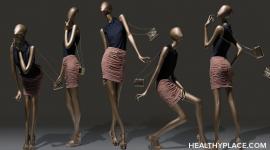Eating Disorders: The Female Athlete Triad - Over-Exercising
Some physically active women are at risk for a group of symptoms called the Female Athlete Triad. This often unrecognized disorder is a combination of three conditions:
- Disordered eating
- Amenorrhea (lack of menstrual periods)
- Osteoporosis
disordered eating, whether manifested as restrictive eating behaviors, binging and purging or excessive exercise, can lead to changes in normal body hormones, such as estrogen. Normal estrogen levels are needed to maintain calcium content in bone. Estrogen levels may be lowered when amenorrhea occurs and as a result, calcium content can be lost from bone. The result is osteoporosis, or porous bones.
Who's at risk: are all athletes on this team?
 If you are a physically active woman, you are at risk for the Triad. The competitive nature and strong discipline that can help make you a good athlete may also be part of the equation leading to this disorder. Competitive athletes may be at a higher risk than the more casual athlete due to a more rigorous training schedule and the "play-to-win" nature of their sports. You are particularly at risk if you participate in endurance sports, like cross-country running; aesthetic sports, like gymnastics or ballet; and sports which require formfitting uniforms, like swimming. The emphasis on a certain "look" and the perception that carrying less weight will universally improve performance lead to this risk.
If you are a physically active woman, you are at risk for the Triad. The competitive nature and strong discipline that can help make you a good athlete may also be part of the equation leading to this disorder. Competitive athletes may be at a higher risk than the more casual athlete due to a more rigorous training schedule and the "play-to-win" nature of their sports. You are particularly at risk if you participate in endurance sports, like cross-country running; aesthetic sports, like gymnastics or ballet; and sports which require formfitting uniforms, like swimming. The emphasis on a certain "look" and the perception that carrying less weight will universally improve performance lead to this risk.
How will the Triad affect my performance?
Each part of the Triad can impair health and sport performance.
Disordered eating:
An underfueled athlete is a slowed and weakened athlete. No matter what the sport, if your muscles lack sufficient and proper fuel, performance is impaired. At first there might just be some early fatigue. As the fuel deficit worsens, actual loss of strength and muscle size can occur as the body uses skeletal muscle in order to fuel essential body functions, like heart function and breathing. Lack of fuel can also lead to your inability to concentrate, not a quality befitting an athlete. If you are an athlete with strength losses and poor concentration, you can be more easily injured. Injuries then are slow to heal in a poorly fueled body.
 Amenorrhea:
Amenorrhea:
Loss of menstrual periods may signal a change in your body's intricate and complicated hormone system. Hormone imbalance from underfueling your body can result in lowered estrogen production. There are also other causes of lowered estrogen levels. A diminished estrogen level can have many effects; the most immediately apparent one can be bone loss. Amenorrhea can often go unreported to medical providers because of the common belief it is "just part of the training effect." We do know that the bone loss that occurs as a result of this is NOT "just part of the training effect" and can start to occur after just a few months with no period. Click for more information on amenorrhea.
Osteoporosis:
Loss of bone, especially if you are an athlete, can be an unfortunate setup for an injury. Stress fractures can sideline sports activity and be slow to repair if you are underfueled. Repeated stress fractures and unexplained injuries should be a red flag to further evaluate your eating and exercise patterns. Bone loss that occurs because of amenorrhea can be permanent; osteoporosis is not just a disease grandmothers get!
What are the warning signs?
In addition to the clinical information presented, the following could be red flags:
- Frequent or unexplained injuries, stress fractures
- Excessive or compulsive exercise (not being able to skip a day of exercise or reduce time spent exercising)
- Change in performance -- loss of endurance, speed, strength
- Impaired concentration
- Absent or irregular menstrual periods
- Restrictive eating masked as a "performance enhancing" meal plan
- Use of weight loss products or supplements
Prevention of the Female Athlete Triad
Prevention of the Female Athlete Triad is the best way to stay healthy so you can enjoy participating in your sport. Try these tips:
- Choose an activity that complements your natural body strengths and suits you as an individual.
- Realize your health is more important than competitive success. Taking health risks for a perceived competitive edge will make you lose in the long run.
- Be wary of those who value your competitive success over your well being. Frequent weigh-ins, weight comments and punitive consequences for weight gain may increase an athlete's risk for the Triad.
- Appreciate your own healthy, active body. Don't compare yourself to others, especially those portrayed in the media. Optimal weight for health AND performance is different for everyone.
- Realize the thinnest athletes are not necessarily the fastest or the strongest.
- Think of fuel as the ultimate performance enhancer!
- Don't starve your bones. Part of your fuel mix should include several servings a day of good calcium sources like milk, yogurt, cheese, calcium-fortified juices and soy products. I f you are lactose-intolerant, try some of the no-lactose dairy products available. Green leafy vegetables, almonds and beans also have some calcium.
- Be a role model with both your words and actions. Speak up when you hear others making negative comments about weight or body shape. Compliment friends and teammates on their talents and personality, not their looks. Take a positive attitude about fueling yourself and enjoying foods.
next: Eating Disorders: Thin Battle
~ eating disorders library
~ all articles on eating disorders
APA Reference
Tracy, N.
(2008, November 21). Eating Disorders: The Female Athlete Triad - Over-Exercising, HealthyPlace. Retrieved
on 2025, December 7 from https://www.healthyplace.com/eating-disorders/articles/eating-disorders-the-female-athlete-triad-over-exercising



